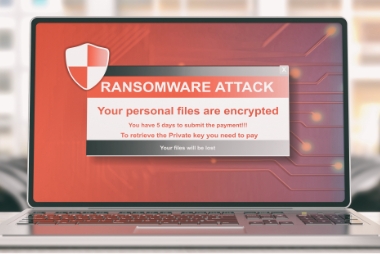Recognize Malware & Ransomware
Cybercriminals use malware and ransomware to disrupt business operations and gain inappropriate access to your information. Email is a primary malware and ransomware attack method.

Malware
Malware is a catch-all term for any type of malicious software designed to harm or exploit any programmable device, service, or network. Cybercriminals typically use malware to extract data they can leverage against victims for financial gain. That data can include financial data, health care records, personal emails, and passwords, to name just a few examples. The types of information that can be compromised are endless.
Signs of a Malware Attack
- Someone else appears to be controlling your computer.
- Your contacts let you know they’ve received strange emails from you.
- Your computer slows significantly.
- Your browser redirects to strange websites.
- Programs open and close on their own, or your computer shuts down and restarts randomly.
- You notice new programs or add-ons that you did not install.
- You get annoying pop-ups.
How did this happen?
- You might have clicked on a malicious link or downloaded an attachment from a phishing email.
- You might have visited a compromised website.
- Your operating system or software isn’t updated properly.
What’s next if I suspect malware?
If you suspect malware, immediately contact the ServiceDesk via ServiceDesk@UTSouthwestern.edu or call 214-648-7600 to report it.

Ransomware
Ransomware is sinister malware designed to encrypt files on your computer, rendering your computer or files unusable. Cybercriminals use ransomware to demand payment to reinstate your access to your files or computer. These criminals might threaten to destroy or expose data or publicly announce the attack to damage an organization’s reputation.
To avoid becoming a ransomware victim:
- Review departmental business continuity plans, and understand operational contingency procedures in the event our network is disrupted or unavailable for an extended period.
- Back up your data to a secure location such as a secure network drive or an approved external device.
- Be cautious when opening documents within emails or clicking links (see Careful Clicking). When in doubt, do not open unexpected or unknown-sender emails. Email is the top malware/ransomware attack method.
- Use multifactor authentication wherever possible.
- Keep your software updated by enabling auto-updates for your computer.
- Use professional antivirus software, and keep it up to date.
What’s next if I suspect ransomware?
If you think your device may have been affected or a ransomware note appears, immediately contact both the ServiceDesk via ServiceDesk@UTSouthwestern.edu and Information Security via informationsecurity@utsouthwestern.edu, or call 214-648-7600 to report it.
Related Terms & Definitions
- Phishing
- Malicious emails designed to gain access to systems by stealing system credentials or to reveal sensitive data such as financial and healthcare records.
- Ransomware
- Malware that locks up or encrypts a victim's information. Critical data is encrypted so the victim cannot access files, databases, applications and systems. A ransom is then demanded to provide access.
Questions about security awareness?
Office of Information Security

